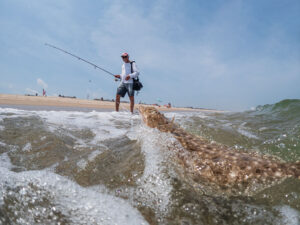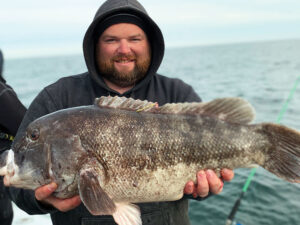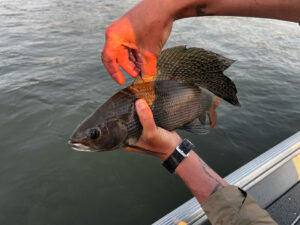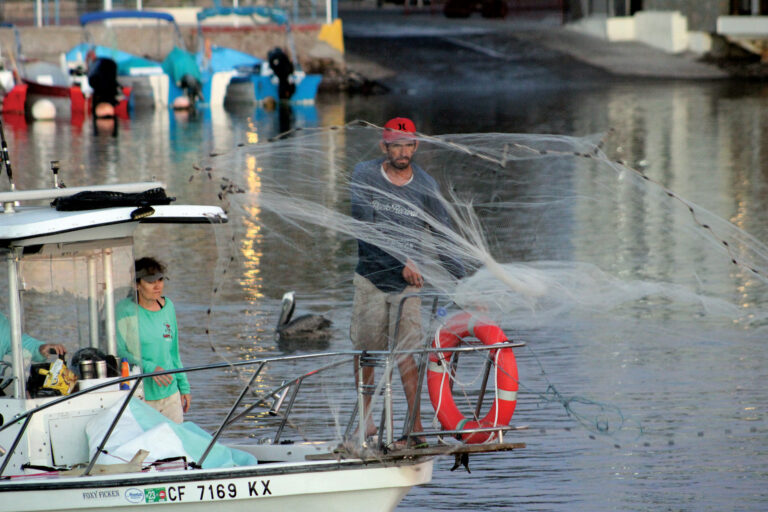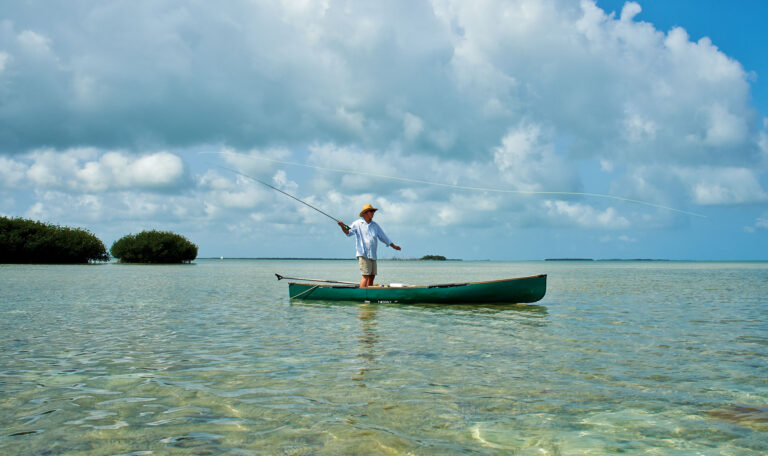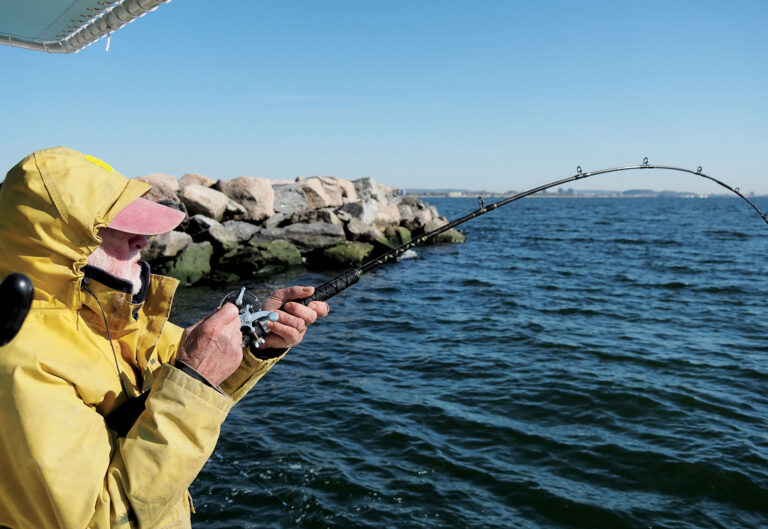Bunker spoons are thin pieces of curved metal shaped like a tear drop with lead keels and an 8/0 to 10/0 hook fastened to the rear. Trolled behind a boat, the metal lures come alive and have fooled many large stripers over the decades. Big striped bass mistake the spoons for adult menhaden (hence the name), a favorite food that can reach 15 inches and weigh more than a pound.
Introduced roughly 60 years ago, bunker spoons epitomize the “large bait, large bass” ethos embraced by many striper anglers. They are trolled on wire line with long mono leaders to get down into the depths where the bigger bass hunt.
 This 40-plus-pounder couldn’t resist a custom bunker spoon created by the Rhodes family.Stephen Rhodes
This 40-plus-pounder couldn’t resist a custom bunker spoon created by the Rhodes family.Stephen RhodesBunker spoons may appear deceptively simple, but getting a piece of steel to flutter and wobble like an erratic bunker involves a ton of trial and error, and many hours of bending and banging metal. Trust me. Others may disagree, but in my experience few methods take more big bass than a properly trolled bunker spoon. Charter captains first began banging on metal decades ago to create purpose-built spoons designed to trigger big bass feeding on big baits into striking.
The exact origin of the bunker spoon is a little fuzzy. A charter boat named Amity out of Sheepshead Bay, New York, has been credited with introducing the large spoons in the late 1940s, according to Capt. Ronnie Lepper, who ran the charter boat Kim out of Deb’s Inlet on New York’s Long Island. With the Amity out-catching Kim 20 stripers to one, Lepper decided to follow the skipper early one morning to unravel his secrets. What he saw were large striped bass cranked from the depths with “huge, ridiculous-looking spoons hanging out of their mouths.” Lepper told several friends, including some of the top bass anglers from Staten Island, New York. Word traveled fast, and it didn’t take long before these sharpies started bending sheet metal, including scavenged street signs and whatever else they could get their hands on.
— Subscribe to the Anglers Journal Newsletter —
In the late 1960s, commercially made bunker spoons started appearing in tackle shops primarily from three small manufacturers: Joe Julian of Julian’s Tackle in Atlantic Highlands, New Jersey, produced what he called Montauk spoons; Lepper came to market with his Lupo Equalizer spoons; and renowned charter-boat owner Capt. Fred Coles of the Janet C, also from Atlantic Highlands, produced Wil-Arm spoons at his machine shop.
 Trolling bunker spoons became popular in the 1960s, especially out of Staten Island, New York, where this image was taken.
Trolling bunker spoons became popular in the 1960s, especially out of Staten Island, New York, where this image was taken.My father, Stephen Rhodes II, a charter captain and marine engineer on the largest fireboat in America — Marine Co. 9, based in Staten Island (see “Passing It On,” Fall 2022 Anglers Journal) — also started to experiment with bunker spoons. Dad and several of his friends from the Fire Department of New York and the New York City Police Department tried every spoon on the market. But spoons were expensive, and these men fished and ran boats on tight budgets. They were, however, good with their hands and decided to create their own. By collaborating, this cadre of spoon-benders came up with new versions in the 1970s, when much of the development of the lure occurred.
This group wasn’t as secretive as some striped bass anglers. They shared designs and worked together. My father took me to Lepper’s house in 1979, when I was 10. I still recall the crackle of the fireplace and the pair of black Labs who watched my every move. My father and Lepper compared notes, and debated hook styles and sizes, keel weight and the thickness of the stainless steel. We still own a dozen of Lepper’s spoons, but my dad bent and shaped them into something radically different. Only the word “Lupo” on the back identifies their origin.
 Ronnie Lepper, a Long Island, New York-based charter captain, was one of the first spoon makers to offer his products commercially. His Lupo spoons were revered by crews along the East Coast.Tom Lynch
Ronnie Lepper, a Long Island, New York-based charter captain, was one of the first spoon makers to offer his products commercially. His Lupo spoons were revered by crews along the East Coast.Tom LynchTaking a piece of metal and turning it into a striper lure is no easy task. Using thick cardboard to make patterns, the makers would cut the metal to shape and then modify the end result on the fishing grounds with Vise-Grip locking pliers. The ’70s were the golden era of spoon-making, as Lepper and Bill Lee, two of the best, shared designs with Tony Galletta, Skip Tellefsen, Donald Larson, Johnny Mester, and renowned tuna fisherman John Swedberg. Now in their mid-80s, most of these captains are still hand-crafting spoons and releasing large striped bass out of Great Kills Harbor on the south shore of Staten Island, where there’s a dedicated tribe of spoon-trollers.
For a time, a handful of New York City firehouses and police stations became think tanks for bunker spoon creators. Lepper, who was a member of the FDNY along with my father, and several others in the spoon-bending ranks would fine-tune their latest creations using workshops in the firehouses and police stations during down times. A vise, hammer and Vise-Grips were always nearby. The banging of metal made a distinct racket that blended seamlessly with the cacophony emanating from New York City.
 The author, Stephen Rhodes III, learned to make custom bunker spoons from his father and has since passed the tradition down the family line.Tom Lynch
The author, Stephen Rhodes III, learned to make custom bunker spoons from his father and has since passed the tradition down the family line.Tom LynchThey started with a basic spoon in a teardrop shape with a rounded head and a lead keel screwed into the front third of the lure. The keels varied in shape and size-, weighing 3 to 12 ounces. The weight helped give the lure its swimming action and got it down into the strike zone. A hole was drilled into the front of the spoon for a 350-pound test split ring, which was connected to the leader with a heavy-duty swivel. A second hole was drilled into the tail portion for a second split ring attached to a single 8/0 to 10/0 Siwash hook. My father preferred a single hook to a treble, as it was easier on the fish when releasing. Both split rings were soldered closed to prevent a lost lure or fish. A natural or synthetic bucktail could be added, as well.
Stainless steel is much more difficult to cut and bend than aluminum or brass, which are soft and can crumple when fighting a large fish. Or the hook could tear out. You must use heavy-duty snips to cut thick stainless; it’s a laborious process. After the main pattern was cut, you’d end up with a template that had to be bent in a vise using hammers. This is handcrafting at its finest — muscles meeting metal until a rough-cut spoon begins to take shape.
 The author and his son John cut out some spoons using heavy-duty snips. Tom Lynch
The author and his son John cut out some spoons using heavy-duty snips. Tom LynchLacking expertise in hydrodynamics, these early craftsmen used trial and error to determine the size, weight and shape of their keels. The best way to test the spoons was on the water. While slow-trolling, traditional wire-line rods would be played out and set to work while a third rod with monofilament would be used to test the spoons alongside the boat. I learned how to steer a boat trolling in a tight fleet in Raritan Bay while my father tested his spoons. He’d change out keels on the spot until he determined the right length and weight for the spoon to swim correctly. Once satisfied, the ultimate test was to see if the spoon would get a striper to hit 20 feet down. If not, it would go back to the testing rod.
 Bending spoons takes muscle and vice grips.Tom Lynch
Bending spoons takes muscle and vice grips.Tom LynchKeel weights were created by melting lead and forming it in homemade molds made from the bottoms of milk cartons, concrete and, more recently, silicone, which lasts longer. Consistency is a perennial issue with hand-made molds, especially given the quality of the lead, which often came from discarded weights used for tire-balancing. Creating consistent keel weights is extremely important when fabricating multiple spoons that will perform in the same fashion at the same trolling speed.
 When you hear banging in the basement, you can expect to see some bunker spoons taking shape.Tom Lynch
When you hear banging in the basement, you can expect to see some bunker spoons taking shape.Tom LynchA trolling expert knows which spoons to use for specific conditions dictated by current, depth and bottom topography. This understanding, combined with knowledge of where bass will be feeding on a specific stage of the tide, separates the very good striped bass anglers from the rest of the fleet.
 Bunker spoons imitate large prey, leading to big bass. Here the author holds up a big striper caught on one of his father’s spoons as his dad looks on.Stephen Rhodes
Bunker spoons imitate large prey, leading to big bass. Here the author holds up a big striper caught on one of his father’s spoons as his dad looks on.Stephen RhodesThe firefighters and policemen further tuned their creations by going head-to-head on the water in informal competitions. Each fisherman selected a spoon to fish on the morning tide, and whoever’s spoon got more fish, won. The other contenders would tweak their spoons in the cockpit in preparation of the afternoon tide. Crews would then swap boats and compete again during the next tide cycle. This let them see if a particular hull impacted the way the spoon swam. On a good day, the best spoons would account for 10 to 15 fish.
There is nothing quite as satisfying as fooling a 50-plus-pound striper on a lure you created — be it a wooden plug, bucktail, fly or bunker spoon. There is little in the fishing world that compares with that level of satisfaction. If you’re not a DIY angler, don’t sweat it; you can buy commercially made bunker spoons and still catch, but that victory may not taste as sweet.
 Fishing with his father as a kid, Stephen Rhodes watched his heroes fine-tune their spoons to catch more bass.
Fishing with his father as a kid, Stephen Rhodes watched his heroes fine-tune their spoons to catch more bass.Last year on Memorial Day, I released two bass that were my personal best. The fish tipped the scales at 62 and 57 pounds, and I was using a spoon my father designed and built. To break the coveted 60-pound mark with my father’s creation was a thrill. My son, John, caught a 50-inch bass on the same trip. It inspired him to follow in his grandfather’s footsteps and start making his own spoons. The sound of John banging away in my basement brings me back several decades, to the small basement where my father played the same tune.

